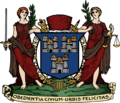



The walls and fortifications around Dublin were raised by the Ostmen in the 9th century, [1] [2] and the majority of the cities in Ireland remained subject to incursions by native clans until the 17th century. [3] The defences of Dublin would eventually fall into disrepair but continued to serve a purpose as late as 1762 when the auction of the rights to collect tolls at each of the then seven city gates raised £4,000 for the city. [4]
Below is a list of the historic Gates of Dublin along the city's ancient boundaries:
| Name | Alternative name | Date | Location | Image |
|---|---|---|---|---|
| St Werburgh's Gate [5] [6] | St Martin's-gate, Le Pole Gate, Pole-gate | 1250 | between Werburgh Street and Bride Street [7] | |
| St Nicholas Gate [6] | 1466 | between St Nicholas Street and St Patrick Street [7] | ||
| New Gate [6] | 1177 | Cornmarket |  | |
| Wormwood Gate | Gormund-gate, Ormond-gate, [6] Earl's Gate | 1261 [7] | Between St Augustine Street and Lower Bridge Street [8] [9] |  |
| Bridge-gate [6] | Ostman's-gate | 1284 | at the Old Bridge over the River Liffey [7] | |
| Dame's-gate [6] | Eastern-gate | 1305 | Dame Street [7] | |
| Essex-gate | 1678 | on the site of Isolde's Tower [7] | ||
| St. Audoen's Gate [6] | Water-gate | 1240 [7] | behind St. Audoen's Church on Cook Street |  |
| Winetavern Gate [10] | King's-gate | 1195 | Winetavern Street [7] | |
| St Austin's-gate | Crow Street [7] | |||
| Gillamocholmog's-gate | 1175 | across from St Michael's Lane [7] | ||
| St Patrick's-gate | 1250 | near St Patrick's Cathedral [7] | ||
| St Kevin's Gate | 1326 | Wexford Street [7] | ||
| Coombe-gate | 1488 | The Coombe [7] | ||
| St James' Gate | 1555 [7] | Meeting of Thomas Street, James's Street and Watling Street [11] | ||
| St Thomas's-gate | 1577 [7] | The Coombe [12] | ||
| The Blind-gate | Hogge's-gate | 1600-1662 | between Dame Street and College Green [7] | |
| Asoold's-gate | Essex Gate | 1220 [7] | Close to Isolde's Tower [13] | |
| Bungan's-gate [14] | 1577 [7] |
